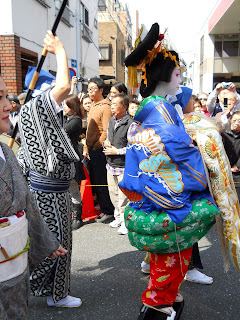 | |
| Photo of flyer. Check out the date-24-4-14. 24 is used because it is the 24th year of the present emperor. |
Behind the Sensoji temple in Asakusa is a
neighborhood where they hold an annual Festival along the main street (lined in
April with cherry blossoms). Highlight is the Oiran Dochu courtesan
procession. Oiran began in the early Edo period (early 1600s) Oiran were
actually prostitutes, and laws were passed restricting brothels to walled
districts some distance from the city center. These areas grew into large,
self-contained "pleasure quarters" offering all kinds of entertainment. Many of
the orian were daughters of poor families who were sold into this lifestyle as
indentured servants. They succeeded based on their beauty, character, education
and artistic ability, including skill in chadō (Japanese tea ceremony),
ikebana and calligraphy. Much like the later geisha.
Oiran were also entertainers and clients expected them to be knowledgeable in scholarly matters. They needed to carry witty and intelligent conversation and write eloquently.
The isolation within the closed districts resulted in the orian becoming highly ritualized and increasingly removed from changing society. Their speech preserved the formal court standards rather than the then-current, common language.
Their clients would summon them with a formal invitation, and the orian would pass through the streets in a formal procession with a large group of servants (the orian dochu). The costumes worn became more and more ornate and complex.
The rise of the geisha ended the era of the orian. Geisha practiced common entertainment preferred by the people of that time and were much more accessible to the casual visitor. The last orian recorded was in 1761.
Oiran were also entertainers and clients expected them to be knowledgeable in scholarly matters. They needed to carry witty and intelligent conversation and write eloquently.
The isolation within the closed districts resulted in the orian becoming highly ritualized and increasingly removed from changing society. Their speech preserved the formal court standards rather than the then-current, common language.
Their clients would summon them with a formal invitation, and the orian would pass through the streets in a formal procession with a large group of servants (the orian dochu). The costumes worn became more and more ornate and complex.
The rise of the geisha ended the era of the orian. Geisha practiced common entertainment preferred by the people of that time and were much more accessible to the casual visitor. The last orian recorded was in 1761.
 |
| I wonder how many ankles have been broken wearing these shoes! |
The costumes and makeup were fantastic. This parade was a true gem!








































